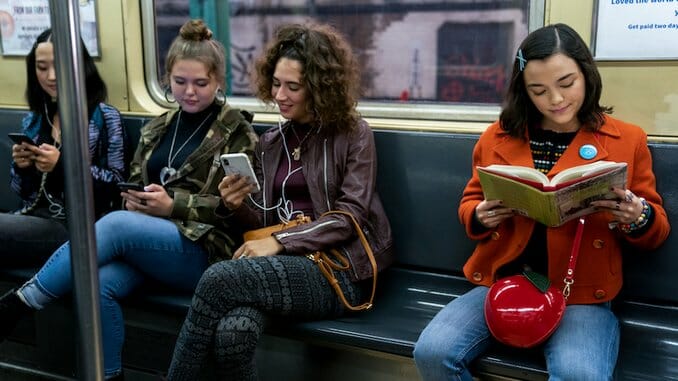Netflix’s Dash & Lily Is a Christmas Treat That Finally Depicts a Realistic NYC
Photo Courtesy of Netflix TV Features Dash and Lily
Christmas in New York is a fabled institution. NYC is the home of the high-kicking Rockettes and the carefully curated Rockefeller tree; a place where gigantic ornaments line the streets of Midtown, and holiday markets pop up throughout the city as soon as the weather starts to turn. It’s hard to not get swept up in the magic of December in the city—except of course if you’re not a Christmas person, like Dash (Austin Abrams) in Netflix’s charming romance Dash & Lily.
Based on the novel Dash & Lily’s Book of Dares, the eight-episode series is a scavenger hunt through New York City, starting at the most romantic place of them all: The Strand Bookstore. Lily (Midori Francis), a lovelorn Christmas truist, leaves a book of clues in the stacks that intrigues Dash (an intellectual teen who hates the entire idea of the holiday), in the hopes of forging a romantic connection on the page. After a series of dares that get each other out of their respective comfort zones and a romantic back-and-forth via written letters in a red notebook, the duo have to face the truth of how their love translates to real life.
As someone who, until recently, had spent the better part of a decade experiencing New York in every season, the show was a welcome depiction of what living there during the tourist-heavy Christmastime is really like. NYC is used as the backdrop for everything, and the stereotypical locations can be counted on one hand: Times Square, Brooklyn Bridge, Empire State Building, etc. But the NYC of Dash & Lily feels lived in and rooted in reality for New Yorkers—even when the teens are partying in a beautiful high rise penthouse on the Upper East Side or spending the night in an iconic museum.
While Dash & Lily’s production team centered the experience in a small subsection of Manhattan’s East Village, picking locations that residents actually frequent instead of tourist traps that even Lily wouldn’t find charming, they also took care to expand the world into other boroughs and non-stereotypical holiday activities. That Dash trekked all the way to Dyker Heights from the Upper East Side (easily an hour and a half or more on the train) to experience the beautiful, famed residential light show, but the duo didn’t step near the tourist-infested Rockefeller tree or make a romantic gesture as the ball dropped in Times Square on New Years Eve showed that the creators knew exactly which version of New York City they were curating.
From the Two Boots Pizzeria in Alphabet City to McSorley’s Ale House near St. Marks, the NYC of this show closely resembled my version of the city, and is the first piece of art that has made me miss those crowded streets and those excellent slices of pizza since I left earlier this year (I highly recommend The Newman slice at Two Boots). In fact, the only thing missing from Dash & Lily’s depiction of Christmastime was a parade of drunk frat boys yelling the lyrics of “All I Want For Christmas Is You” in an East Village bar during Santacon, but we’re all better off without that experience.
Beyond just the physical locations, Dash & Lily’s diverse cast and characters resemble the melting pot of cultures and walks of life that make up the true fabric of New York City. From the top of the bill with Lily—a half-Japanese girl with an out-and-proud brother, both of whom live in a multigenerational household—to Lily’s classmates at school who are Latina, Black, Indian and everything in between, the show makes a conscious effort to depict the characters’ worlds as full as the real New York.
Perhaps most importantly, at the center of the story are three-dimensional characters who anchor the story in surprising yet believable ways. Lily’s hyphenated identity isn’t a source of confusion—instead she was just a weird girl who was determined to own her weirdness and work through the trauma of being bullied for it in real time (and in very New York fashion, via a standup set). Dash, the son of divorced parents, felt the emptiness of spending the holidays alone but didn’t have to act out to get their attention or convey his unhappiness. Lily’s brother Langston isn’t shamed for his identity as a gay Asian man, and it was refreshing to see a gay story that wasn’t centered on a struggle with acceptance, but rather his own shortcomings with trust in relationships.
Above all, Dash & Lily is a delightful holiday series that reminds us how festive and cozy the Christmas season normally feels, whether you usually celebrate in a city like New York or in your small hometown—or whether you celebrate Christmas at all. In a holiday season that continues to be unlike any other before it, celebrate the good things and treat yourself to a binge of Dash & Lily.
Dash & Lily is currently streaming on Netflix.
Radhika Menon is a pop culture-obsessed writer and filmmaker living in New York City. Her work has appeared in NY Post’s Decider, Teen Vogue, and will be featured in Brown Girl Magazine‘s first ever print anthology. She is a proud alumna of the University of Michigan and thinks she’s funny on Twitter.
For all the latest TV news, reviews, lists and features, follow @Paste_TV.